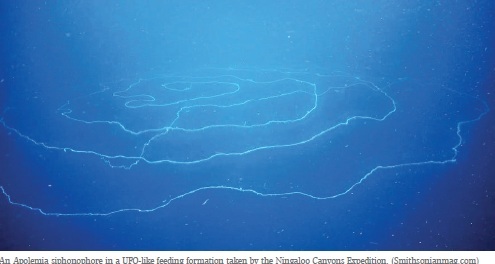By Janina Castro
Humans have always been enamored by sea creatures. Sailors traveling at sea for months on end have encountered animals that inspired many mythological stories. Stories of dugongs turned into legends of mermaids: those of oarfish led to mysteries about sea serpents: and giant squids were portrayed as the kraken, according to a 2014 article by Grace Constantino for the Smithsonian Magazine.
There’s one deep-sea animal not yet turned into yet another mythical creature by sailor’s stories, yet it looks like it came right out of a science fiction novel: the siphonophore.

The pelagic siphonophore is just an example of animals under the order of Siphonophores – animal colonies of smaller individuals. Siphonophores are cnidarians, a word derived from the term cnidae, which are stingers found in the cells used for defense and catching prey.
Curious cousins
Corals, sea anemones, sea fans, and jellyfish are also Cnidarians, according to a 2020 article by Daphne Gail Fautin for Encyclopedia Brittanica. In fact, siphonophores up close can look a lot like jellyfish.
Their gelatinous bodies are usually colorless, but there are some deep sea species with red digestive systems, while others are bioluminescent and would glow blue or green when stressed, according to Siphonophores.org.
“Longest creature”
According to Casey Dunn in a 2009 article for Current Biology, the pelagic siphonophore has also been dubbed the world’s longest creature since it can reach up to 40 meters or even longer, but they are usually no thicker than a broomstick. These rope-like creatures are also called superorganisms because they are a large colony of small animals called zooids. Each zooid is assigned a specialized task to help the colony survive, much like different organs in the human body.
One curious characteristic of siphonophores is how each zooid can be considered an individual animal, but these individuals cannot survive without being part of a colony. As a collection of animals, they are voracious eaters, passing food to each other through canals in their bodies. Each species has their own distinct pattern of zooids, which helps in their identification.
Not a jellyfish

Another famous example of a siphonophore is the Portuguese man o’ war (Physalis physalia), a rather highly venomous sea creature. Most people think this is a type of jellyfish when they see it floating on the surface of the water with its long tentacles reaching down into the ocean, but it’s a colony of zooids, not a single organism, as mentioned by Catriona Munro and colleagues in a 2018 article published by Molecular Phylogenetics and Evolution.
One for all
For the pelagic siphonophore, each cell has a different task, such as capturing prey, getting rid of waste, reproduction, or moving the giant colony around. Each cell is attached to the main stem and comes from one fertilized egg. As they grow, the fertilized egg divides into genetically identical cells with specialized body structures, depending on their role in the colony. This will form the first “body.:
Growth zones eventually appear that replicate the pattern of the first “body,” and this continues throughout the life of the siphonophore, leading to the giant superorganism.
One deep-sea siphonophore, Marrus orthocanna, feeds by unleashing a curtain of tentacles, each around 12 to 20 inches, in front of its body to catch small crustaceans like krill, mysids, and copepods. Sometimes, they also manage to catch small fish. on these tentacles are nematocysts, the stinging cell structures that have small “harpoons” filled with toxins that can paralyze and kill prey.
Watch, don’t catch
Much like their jellyfish cousins, siphonophores’ bodies are soft and spongy, making it very difficult to capture them with nets for research because they would disintegrate.
Scientists observe them in submersibles at depths up to 2,000 meters, but they have also been spotted in waters 4,300 meters deep.
They are known to be one of the most abundant gelatinous predators that exist in the open ocean and are vital for ocean ecosystems.
Moving mush
They have specialized zooids for mobility called nectophores or swimming bells that look like the bell of a jellyfish, said Gillian Mapstone in his 2015 article published in PLOS ONE. To get around, each bell-shaped netophore contracts, releasing a small jet of water. When all of the cells contract and relax in coordination, the entire colony can actively move around as they wish.
Nearly all siphonophores live in the deep sea and can be found in the Mediterranean, Pacific, Indian, and Atlantic oceans. However, they are highly dependent on oceanic temperatures and currents, and some species can only be found in certain latitudinal bands.
Little is known about these suprorganisms, so we don’t know how they will be affected by climate change. Since they eat all kinds of small creatures, they may ingest plastic waste that makes its way into the deepest parts of the ocean, according to Monterey Bay Aquarium’s website.
In other words, these ethereal creatures are not as far away as we think they are, and if we’re not careful, they may disappear into legends.
This appeared in Animal Scene magazine’s September-October issue.
You might want to read:
– Orange cats are more special, new scientific study shows
– GloFish: Brilliant newcomers
– Animal companions linked to better mental health during lockdown, new research shows






